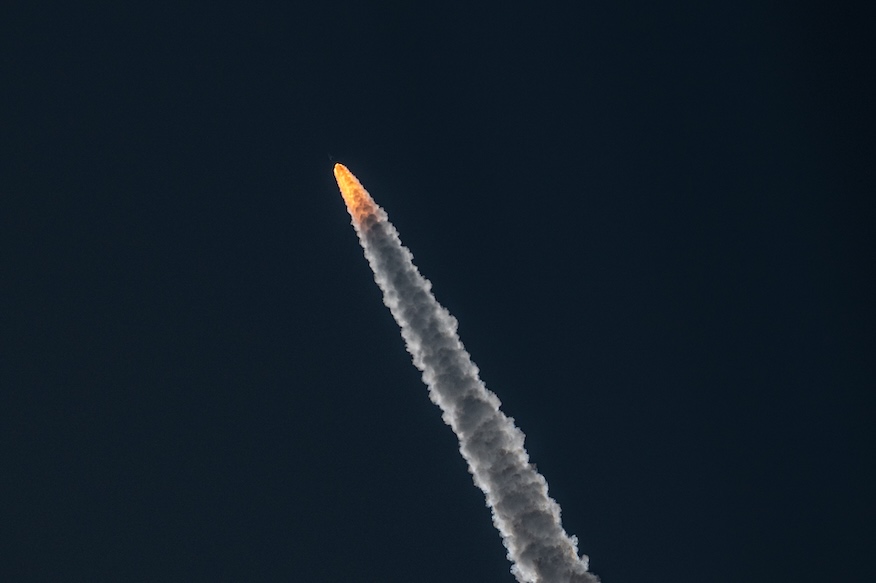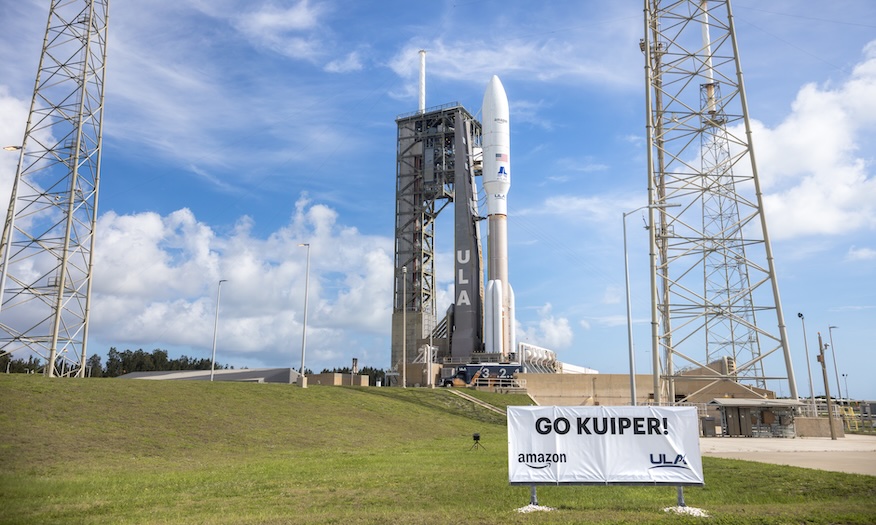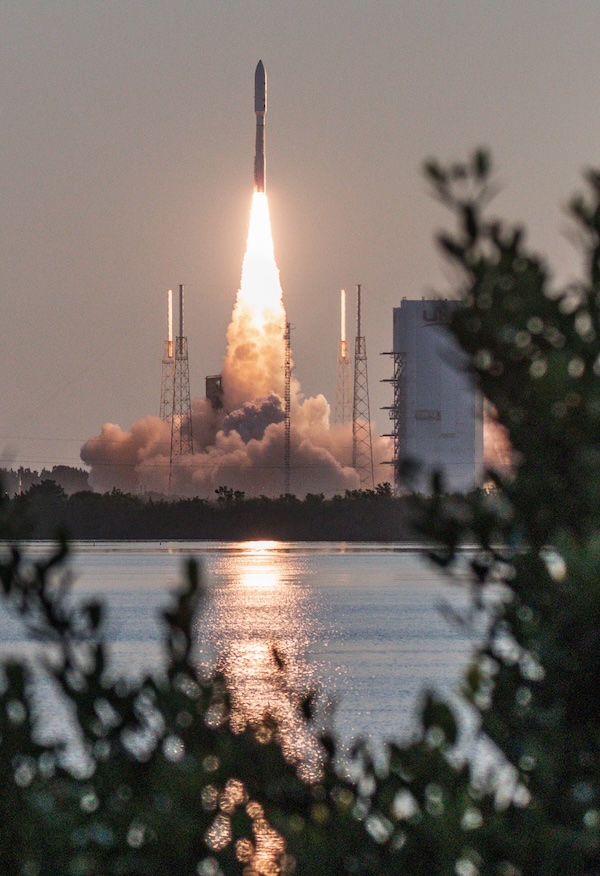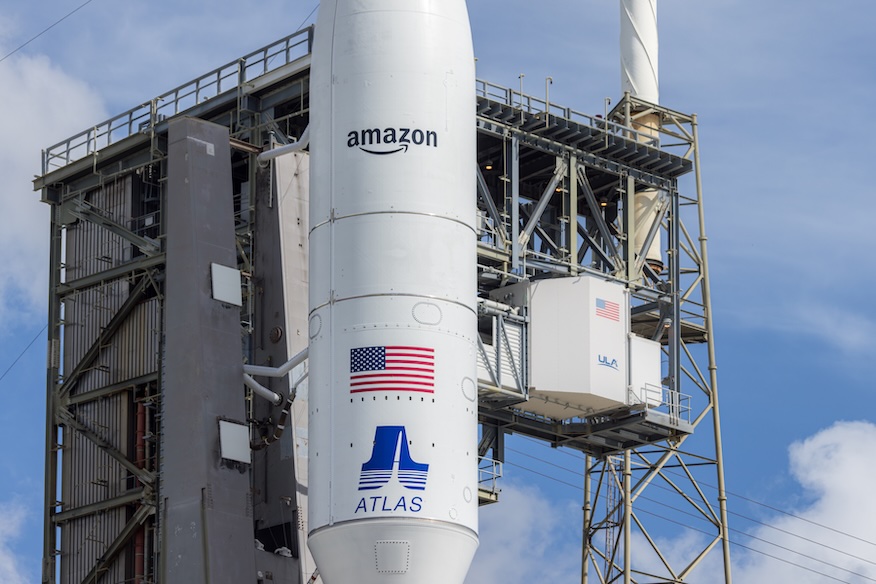
Update June 23, 7:23 a.m. EDT: ULA launched its Atlas 5 rocket.
For a second time this year, United Launch Alliance launched an Atlas 5 rocket carrying 27 of Amazon’s Project Kuiper internet satellites into low Earth orbit. This was just the second production batch that will make up a constellation of more than 3,200 satellites eventually.
Monday was also the second attempt to launch this mission, dubbed Kuiper 2 by ULA, following a nitrogen purge issue connected to the rocket’s booster engine that caused a scrub on June 16 and for the rocket to be returned to the Vertical Integration Facility to address the issue.
Liftoff for the 205-foot-tall (62.5 m) rocket happened at 6:54 a.m. EDT (1054 UTC) from Space Launch Complex 41 at Cape Canaveral Space Force Station, the opening of a 30-minute launch window.
On Sunday, the 45th Weather Squadron forecast a 80 percent chance for favorable weather conditions at launch time, listing concerns only for cumulus clouds and low to moderate solar activity.
Teams progressed through a smooth, quiet countdown to liftoff and weren’t working any issues in the lead up to launch.
Like it first did a week ago, ULA rolled its Atlas 5 rocket out from the VIF on a journey of a third of a mile to the launch pad on Saturday. Launch teams spent part of the day loading RP-1, a rocket-grade kerosene onto the rocket in preparation for launch day fueling.

The launch carried the ULA designation of AV-105 and it was the 103rd launch of an Atlas 5 rocket. ULA refers to the mission as Atlas 5 Kuiper 2 or simply Kuiper 2.
This launch will be followed by a pair of national security missions using the company’s Vulcan rocket and then ULA plans to launch its first batch of Kuiper satellites on a Vulcan rocket from Cape Canaveral. Vulcan can send 45 Kuiper satellites into LEO as opposed to the 27 that an Atlas 5 rocket can support.
Following Monday’s launch, ULA has six more Atlas 5 rockets that have been purchased by Amazon to fly satellites for its constellation. The tech giant procured nine in total, but the first was used on a dedicated mission solely for the demonstration Kuiper satellites in a mission dubbed Protoflight.

Creating a cadence
Amazon is up against a regulatory clock to get its satellites on orbit and in a functioning constellation. It has a requirement from its agreement with the Federal Communications Commission (FCC) to get at least half of its planned first-generation constellation of more than 3,200 satellites in operation by the end of July 2026.
In addition to the remaining Atlas 5 rockets at its disposal, Amazon also purchased 38 Vulcan rockets, 18 Ariane 6 rockets, 12 New Glenn rockets (with the option to add another 15) and three Falcon 9 rockets from ULA, Arianespace, Blue Origin and SpaceX respectively.
When it announced the purchase of the Falcon 9 flights from SpaceX, Amazon said in December 2023 that it would begin launching on this rocket in mid-2025. Since then, Amazon has not commented on whether or not it is still on pace with satellite production or delivery to meet that timeline.
Both Blue Origin and Arianespace have not discussed their launch manifests extensively in a public setting, but both companies are aiming for their next launches in the August timeframe and neither will be with Project Kuiper satellites on board. It remains unclear when the first Kuiper launch will take place with those rockets.
Take a look at this @ULAlaunch clip of the first Kuiper satellites being released into low Earth orbit approximately 280 miles above the planet. Deployment takes place over a 15-minute period after launch, with satellites released three at a time from the dispenser system. pic.twitter.com/bZ1zUy3IWs
— Project Kuiper (@ProjectKuiper) May 2, 2025
It created a new page on its website on June 10, 2025, that it said contains “updates on recent and upcoming Project Kuiper missions.” As of June 15, the page didn’t include references to any other launches beyond what it designated as KA-02 and the previously launched KA-01, which lifted off on April 28.
“ULA will deploy the satellites at an altitude of 280 miles (450 kilometers) above Earth, at which point the Project Kuiper team will take over command of the mission from our 24/7 mission operations center in Redmond, Washington, confirm satellite health, and ultimately raise the satellites to their assigned orbit of 392 miles (630 km) above Earth,” Amazon wrote regarding the upcoming launch.
This second flight for Amazon brings its constellation up to 54 satellites in total out of the more than 1,600 it needs in just a little more than a year’s time. In a post on LinkedIn, Rajeev Badyal, the vice president of Technology at Project Kuiper said April’s launch made him optimistic about the direction of the company.
“The success of our first full-scale Kuiper mission in April meant we could move immediately to our next launch,” Badyal wrote. “All 27 satellites for our KA-02 mission were fully integrated within 17 days of that first launch, and ULA plans to send them into orbit next Monday. Thanks to the entire team for the quick turnaround. Go Kuiper. Go Atlas. Go KA-02!”
A key test for Amazon will be how quickly it can get back to the pad with its satellites, whichever rocket will be ready to fly them.

source: spaceflightnow.com